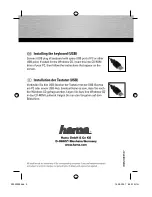
Section 12 — Sequencer and Audio Track Concepts
ASR-10 Musician’s Manual
26
About Audio Tracks
The ASR-10 can play a maximum of two Audio Tracks at one time. Since the Song contains two
song-length Audio Tracks, and the Song plays sequences that also have their own associated
Audio Tracks, you must decide which pair of Audio Tracks you want to play. Use the
Command/Seq•Song, SET SONG ATRK PLAYBACK command to do this.
Note:
All sequences used within a song must have the same Tempo and Time Signature in order to
record Song Audio Tracks.
All About Memory
How much memory you have for recording and playing back Audio Tracks is dependent on
whether you are configured for RAMTracks or for DiskTracks:
RAMTracks (Audio recorded into RAM)
RAMTracks are the simplest type of Audio Track Recording. However, even with the ASR-10
memory fully expanded (16 meg), RAMTracks do not offer as much recording time as
DiskTracks.
Internal RAM Memory and SIMMs
The internal RAM memory is shared by Instruments, sequences, and AudioSamples, and is
distributed dynamically. This means that the more sounds and sequences you have in memory,
the less AudioSample memory you have. This is why we recommend expanding the memory if
you plan to do a lot of RAMTrack recording. The ASR-10 can address up to 16 Megabytes/8
Megawords using industry standard SIMMs.
DiskTracks (Audio recorded to a SCSI storage device)
DiskTracks allow a longer recording time than RAMTracks, but require you to configure the
ASR-10 to recognize the SCSI storage device (how to configure the ASR-10 for DiskTracks will be
explained later). Because some internal (RAM) memory is required as a buffer, we recommend
expanding the ASR-10 memory to at least 4 Megabytes for improved performance.
Note:
DiskTrack performance is dependent on the speed of the SCSI storage device and the extent of
data fragmentation on the disk (see below).
















































